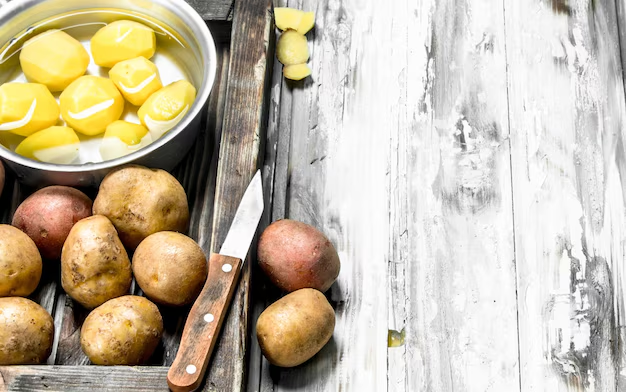Should You Store Potatoes in the Refrigerator? A Comprehensive Guide
Potatoes are a pantry staple in many households, beloved for their versatility and ability to be stored for long periods. But when it comes to storage, there’s often debate: Is it okay to put potatoes in the refrigerator? By exploring this topic from several angles, you'll gain a clear understanding of the best practices for storing potatoes, the science behind how they react to refrigeration, and useful tips for keeping them fresh. Let’s dive deeper!
🥔 Why Potato Storage Matters
At first glance, potato storage might not seem like a priority. However, the way you store these tubers can significantly impact their texture, flavor, and nutritional value. Proper storage extends their shelf life, reduces food waste, and ensures they contribute healthily to your meals.
The Structure and Composition of Potatoes
Potatoes are composed of carbohydrates, particularly starch, which plays a crucial role in their response to different storage environments. They also contain vital nutrients such as vitamin C, potassium, and fiber, making them a nutritious addition to your diet. Understanding their biological makeup helps explain their sensitivity to temperature and humidity changes.
🍽️ The Effects of Refrigeration on Potatoes
Refrigeration isn't just about keeping things cool; it's about managing the conditions that influence food longevity. When it comes to potatoes, refrigeration can have unintended consequences.
Starch Conversion
One major concern is starch conversion. When potatoes are stored in the cold environment of a refrigerator, their starches turn into sugar. This conversion can lead to a sweeter taste, which may not be desirable for all recipes. Additionally, when these refrigerated potatoes are cooked, especially by frying, the increased sugars can lead to higher levels of a chemical called acrylamide, which is a food safety concern.
Texture Changes
Cold temperatures can also affect the texture of potatoes. The increased sugar levels can compromise their firmness, making them less desirable for certain culinary applications like roasting or frying.
🔍 Ideal Conditions for Storing Potatoes
Now that we understand the potential pitfalls of refrigeration, let's explore the best conditions for storing potatoes to maximize freshness and nutritional value.
Temperature and Humidity
Potatoes prefer a cool, dark, and well-ventilated environment. A temperature range of 45 to 50°F (7 to 10°C) is ideal for inhibiting sprouting and maintaining their texture. Too much moisture can encourage mold growth, so moderation in humidity levels is critical.
Darkness and Light
Exposure to light can prompt potatoes to turn green and produce solanine, a bitter-tasting compound that can be harmful if consumed in large amounts. Therefore, storing them in complete darkness is essential to prevent this chemical reaction.
🌱 Ethical and Practical Approaches to Potato Storage
With growing awareness of sustainability, many consumers are interested in ethical and practical approaches to storing food. Understanding and implementing these practices ensures that your potatoes remain fresh and tasty while also reducing your environmental footprint.
Using Root Cellars
Traditionally, root cellars have provided the optimal environment for storing root vegetables like potatoes. Their natural insulation maintains stable temperatures and humidity levels, extending the life of stored produce without the need for electricity.
Alternatives to Refrigeration
If a root cellar isn't an option, consider using a mesh bag or a breathable container to store potatoes in a cool basement or pantry. This method allows for air circulation while protecting the potatoes from light and excessive moisture.
🍟 Cooking with Refrigerated Potatoes
If you’ve already refrigerated your potatoes, don't worry! While they might not be best suited for all recipes, there are culinary options where a sweeter potato can be utilized effectively.
Recipes for Sweeter Potatoes
Potatoes that have been refrigerated can lend themselves well to certain dishes. Consider using them in:
- Mashed Potatoes: The slight sweetness can complement the creamy texture.
- Potato Soups: Sweet or savory, the sugars can balance well with the dish's flavors.
- Baking: Incorporate them into bread or cake recipes where sweet notes enhance the overall flavor.
Counteracting Sweetness
If you'd prefer a more neutral taste, bathing refrigerated potatoes in lukewarm water and allowing them to rest at room temperature for a few days may help reverse some of the sugar conversion. This method helps in re-converting some of the sugars back to starches.
📋 Quick Reference Summary
Here's a handy checklist to ensure your potatoes are stored optimally without refrigeration:
- 🌡️ Store Temperature: 45-50°F (7-10°C)
- 📦 Storage Container: Dark, breathable bags or containers
- 🚫 Avoid: Light exposure to prevent greening
- 🌬️ Air Circulation: Ensures moisture control
- 🧊 Alternatives to Refrigeration: Mesh bags, root cellars, or dark basements
🕹️ Making Informed Choices
Understanding the nuances of potato storage empowers you to make choices that will keep your kitchen more efficient and your meals flavorful. Whether you opt for traditional storage methods or experiment with your refrigeration options, the insights shared here offer a comprehensive foundation for successful potato storage practices.
In the end, whether it’s the perfect roast, a comforting mash, or a savory soup, storing potatoes correctly ensures they’re always ready to shine in your favorite dishes. By mindfully managing these starchy staples, you contribute to reducing food waste and enhance the sustainability of your kitchen.
